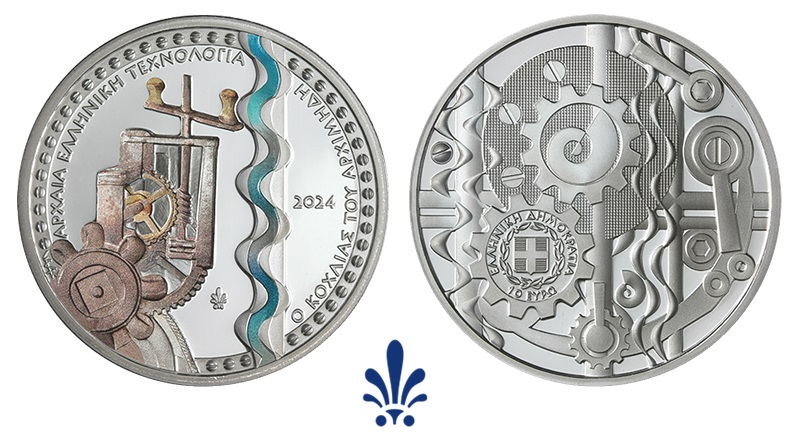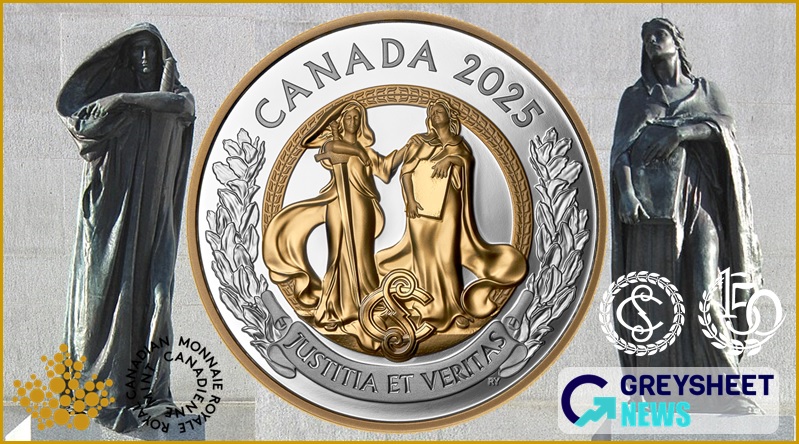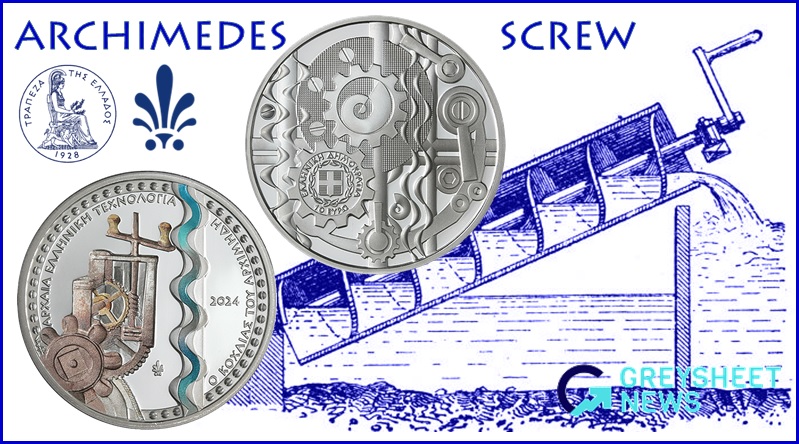Greece: Ancient Greek Technology Features on New Silver Proof Coins Highlighting Archimedes Screw Component
The Bank of Greece have launched their latest silver proof collector coins in an innovative entitled Ancient Greek Technology focusing on some of the most inventive devices which emerged during the Hellenic antiquities era.
Named for its inventor, the Greek mathematician Archimedes of Syracuse (237-212 BC), the second coin highlights the genius of the Archimedes screw, a device for raising water. The Archimedes screw is essentially a hollow tube that contains a spiral or helix that winds its way up the cylinder. The bottom end of the tube is then placed in a body of water, and the spiral is rotated. As the screw turns, it scoops up some of the water. Further turns raise the water through consecutive pockets of the helix until it reaches the top of the tube. There’s evidence that the Archimedes screw was in use during the Hellenistic period of ancient Egyptian history, in around the 3rd century BC. At that time, the Archimedes screw was used to raise water from the Nile, functioning as an irrigation tool.
Why or how did this marvellous invention come to be? One theory suggests that Archimedes invented the screw pump as a solution to the Syracusian King Hiero (r. 275 – 215 BC) who had ordered that a tool be created to remove water from the hull of a ship, which led Archimedes to create the screw pump. The Archimedes screw would go on to serve as a vital aid for irrigation across the ancient world, typically as a means of raising water from rivers and lakes into agricultural lands.
To this day, screw pumps are used in water treatment plants around the world to move water and sewage. The technology has also been applied worldwide to enable water fountains to function. If water is directed or flushed into the top of an Archimedes screw, rather than the bottom, it forces the spiral to rotate independently and this action can then be utilised as a form of electricity generation. Hydro-generating pumps of this sort were first used on the River Thames in England, and the electricity generated was directed in Windsor Castle, one of the first structures to benefit from such technology.

The coins are produced by the Bank of Greece’s own Minting facilities in Athens and designed by artisan engraver George Stamatopoulos. The obverse side depicts a portion of an Archimedes screw with the gears, handle and spiral visible. To the right is a vertical blue ribbon symbolising both water and the helix which is the primary element of the invention. Shown to the right is the year of release, 2024 and to the lower left is the distinctive mintmark of the Greek Mint, a stylised palmette. Surrounding the primary design is the inscription ΑΡΧΑΙΑ ΕΛΛΗΝΙΚΗ ΤΕΧΝΟΛΟΓΙΑ - Ο ΚΟΧΛΊΑΣ ΤΟΥ ΑΡΧΙΜΉΔΗ (Ancient Greek technology – Archimedes' screw) along with a frame of flat-head screw tops. The primary design and blue ribbon is highlighted by elements of subtle colour tint. The reverse side depicts a stylised representation of both the application and movement of the Archimedes screw. Located to the lower left is the crest of the Hellenic Republic with the text ΕΛΛΗΝΙΚΉ ΔΗΜΟΚΡΑΤΊΑ (Hellenic Republic) and the coins’ denomination 10 EYPΩ (10 Euro) shown just under the crest.
| Denomination | Metal | Weight | Diameter | Quality | Maximum Mintage |
| 10 Euro | .925 Silver | 34.1 g. | 40 mm. | Proof & colour | 2,000 |
Available from the 28th March, the coins are encapsulated and presented in a Bank of Greece-branded custom wood case accompanied with a certificate of authenticity. For additional information, please visit the website of the Bank of Greece.

Download the Greysheet app for access to pricing, news, events and your subscriptions.
Subscribe Now.

Subscribe to RQ Red Book Quarterly for the industry's most respected pricing and to read more articles just like this.
Author: Michael Alexander
Related Stories (powered by Greysheet News)
View all news
The IPZS release new collector coins featuring one of the country's most well-remembered politicians.

The Royal Mint release new £2 coins marking the 350th anniversary of the Royal Observatory.

The Royal Canadian Mint release silver proof coins marking the 150th anniversary of the Supreme Court.









Please sign in or register to leave a comment.
Your identity will be restricted to first name/last initial, or a user ID you create.
Comment
Comments